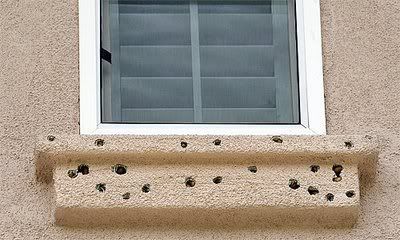
If you’re a homeowner in any area where there are trees, you’ve probably had problems with woodpeckers. They often drill nasty, gaping holes in your siding, fascia boards, EIFS, and those beautiful architectural elements created with foam.
The problem is compounded by the fact that woodpeckers are classified as migratory, non-game birds and are protected by the Federal Migratory Bird Treaty Act. So forget about poisons or pellet guns. Lethal controls or nest destruction can only be implemented with a special permit issued by the Law Enforcement Division of the US Fish and Wildlife Service, and after recommendation of USDA-APHIS-Wildlife Service’s personnel.
So what can you do to protect your home from woodpecker damage? Fortunately, there’s a humane and highly effective woodpecker deterrent that’s recently been developed. It’s Called BeakGuard.
BeakGuard Works
BeakGuard is a paint-on Woodpecker Deterrent that quickly conveys a warning signal to any woodpecker that may be tempted to start pecking on your home. The results are startling and virtually immediate. After two years of field testing in the most prolific woodpecker areas of the country including Montana, Colorado, South Dakota and Washington, BeakGuard scored a success rate that exceeded 90% in deterring further building damage.
BeakGuard was tested on building structures experiencing ongoing woodpecker problems. In one test, a remodeled office building outside of Seattle, Washington with large EIFS cornices (coated foam insulation) was assaulted by woodpeckers every season. Some years the drumming resulted in more than 10 holes around the building—holes that eventually became nesting sites for smaller birds. The holes had to be filled with spray foam, sanded and refinished every year. After coating the building with BeakGuard, not a single woodpecker has damaged the building.
BeakGuard is Easy to Apply
Easily applied to latex painted surfaces, wood, fiber-cement, stucco, aluminum or vinyl, BeakGuard is an elastomeric acrylic. You can apply it with a brush, roller, paint pad or appropriate spray equipment. One gallon covers about 180 square feet. Thinning of the product is not recommended. BeakGuard should be screened prior to spray application, and the manufacturer recommends that you don’t thin the product. Back-roll BeakGuard when applying over acrylic finishes or other textured substrates. Depending on your climate, BeakGuard usually dries in just 24 hours.
BeakGuard Won’t Harm Birds
BeakGuard uses a common compound that will not harm woodpeckers or any other bird species. In fact, the ingredients in BeakGuard are used in many consumer products on the market today. Products like nail biting and thumb sucking deterrents used to break children of these habits use this technology.
BeakGuard Lasts and is Color Fast
Beakguard is specially engineered to leave a durable, long lasting finish. It resists dirt pick up and holds up to season after season of rough weather. It leaves a vapor permeable, flexible membrane that ensures the color won’t fade or change in tone.

by Alex A. Kecskes
Summer’s finally here and you’re ready to invite friends, family and neighbors to your patio for a fun-filled BBQ. The last thing you need is bird poop all over your BBQ, patio cover, balcony and walkways. Or to have annoying birds dive bomb your gests and kids as they try to enjoy their outdoor summer treats.
Yes, there are bird poisons and you could whip out your trusty BB gun. But do you really want to subject kids and pets to such extreme, potentially hazardous measures? Also keep in mind that in many states and municipalities, it’s against the law to kill or harm certain birds. Banging pots and pans and shooting off firecrackers will scare birds away—but only for a little while. Unless you use permanent and effective bird control measures, they’ll come back in droves when they get a whiff of your outdoor cooking.
Fortunately, there are a number of effective bird proofing devices that will keep pest birds away from your patio and balcony. Measures you can employ without risking injury to kids, birds or pets. They include:
Visual Scare Deterrents. These are fairly economical and easy to attach to various areas of your balcony, patio, or gazebo. They include a variety of flash tape and reflective banners that reflect sunlight and crackle in the breeze. The audio/visual elements combine to create a distraction that makes pest birds feel uneasy. You can also get Bird Scare Balloons—beach ball sized bird deterrents emblazoned with large predator eyes. Birds really feel uncomfortable with these. Likewise for Bird Scare Diverters, which are bladder shaped deterrents that have a large eye on them. Remember that birds are not dummies, so you’ll need to move them around occasionally to prevent the little critters from getting used to them.
Bird Sonics. These time-proven bird deterrents can be discretely installed on patio covers, under eaves or and inside gazebos. They can keep pest birds away from large outdoor areas by emitting predator and distress calls that birds instinctively hate. They capitalize on a bird's innate fear of predators, as well as their acutely sensitive hearing (birds can process sounds in 1/200th of a second; humans process sounds in 1/20th of a second).
Sonic devices will guard your patio and balcony against pigeons, crows, starlings, swallows, gulls, woodpeckers, sparrows, grackles, cormorants and many other types of birds. One of the most effective sonic systems broadcasts the sound of Peregrine falcons (a pigeon's dreaded enemy) defending their territory. Other systems will deter starlings and seagulls with the sounds of predator hawks screeching and gulls under attack. Try to get sonic bird control systems that alter the pitch, frequency, timing and intensity of the sounds they emit. You don’t want pest birds to get used to hearing the same sound over and over. One highly regarded system emits distress and predator calls for as many as 22 types of birds. The calls are cycled through every fifteen minutes. One thing to keep in mind is that sonic bird deterrents will not harm birds, pets or humans. The sounds they emit are normal bird sounds.
Scarecrows. These ingenious devices are basically motion-activated sprinklers that give pest birds a hefty blast of water the second they enter the preset radius of protection. The sudden blast of water, alarming sprinkler sound and realistic looking bird head is enough to convince most birds that this is not a hospitable area. Scarecrows connect to almost any garden hose, yet they consume just 2 to 3 cups of water per blast. They cover about 1,200 square feet with a stream that reaches out 35 feet and 45 feet wide. They stand guard 24/7 for up to 6 months and deliver over 1,000 "firings" on a single 9-volt battery. You can even fine-tune their sensitivity and coverage distance. By the way, kids and dogs love to play with these devices.
Hawk Decoys. Get one or two of these decoys, strategically place them around your patio or balcony and pest birds will stay away. You’ll need to move them around and reposition them from time to time for best effect. Hawks are the natural predators of most pest birds and they hunt during the day. Be sure to get the most realistic looking bird available. And make sure they are quality fabricated of heavy-duty plastic so they stand up to the elements. Some decoys have a hollow bottom that allows them to be filled with sand for greater stability on windy days.
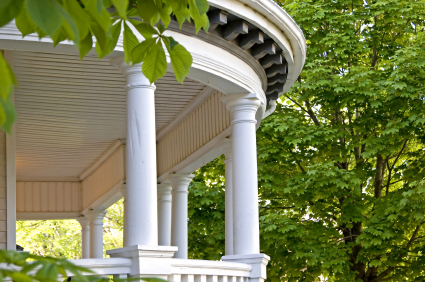
Many homes in the South and mid west are graced with beautiful wraparound front porches. They serve to draw friends and neighbors for long hours of conversation and relaxation. They’re also ideal for parties and other informal get-togethers.
Trouble is, these attractive gathering places also draw pest birds. Now, most people enjoy the sounds of birds in trees, but without proper bird control, birds can take over a veranda or front porch. These architectural features often have seemingly endless nooks and crannies where birds can roost and build nests. Nothing is more irritating than discovering bird droppings on a table, chairs or glider you’ve set out on the porch or veranda. Attract enough birds and you’ll face a daily cleaning chore getting rid of bird droppings.
If you’re like most nature loving people, you won’t want to harm these birds. You just want to keep them out of your front porch and off your tables and chairs. That means you naturally object to using bird poisons and other harmful bird deterrents. The good news is, there are a number of humane and highly effective bird deterrents you can use to keep birds away from specific areas of your home. These include:
No Nasty Nest
These hanging "twine" deterrents are ideal for keeping swallows away from common nesting areas. Birds of any kind will be reluctant to work their way past the twine strips and simply move on. If you've encountered swallow mud nests under the eaves and sides of your porch or veranda, this deterrent will keep them out. Every strip of No Nasty Nest features a self-adhesive back for quick installation on eaves, gables, entryways and other areas. Bird Slope
These angled, slippery PVC panels deny birds a place to land. They’re easily installed under eaves and are ideal for preventing swallows from building nests. Bird slopes can be installed on almost any surface using nails, screws or glue. Bird Slope comes in a 4-foot kit that contains two 2-foot long sections of slope, two end caps and one tube of glue. Bird slope is ideal for ledges up to 6 inches wide. It also comes in several colors to blend in aesthetically with your front porch or veranda.
Hawk Decoys
Decorative and functional, Red-Tailed Hawk decoys convince birds that their natural enemy is on the premises. Place one or two in “problem areas” and birds will stay away. Perfect for use in porches and verandas, Hawk Decoys are easily placed or hung in conspicuous areas to discourage pest birds. Birds will communicate with each other and spread the word that your porch or veranda is “occupied” by a predator. Be sure to choose a high quality decoy made of heavy-duty plastic, as it will remain realistic looking after years of outdoor exposure. For best results, be sure to move the decoy around often to ensure bids don’t get used to it.
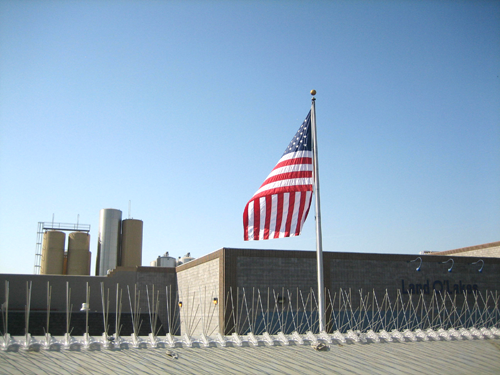
by Alex A. Kecskes
No matter how you feel about birds, when they invade your property en masse, they can be a real nuisance. Consider the damage just a few bids can do to your gutters, rooftop AC units, skylights, air vents and solar panels. Over time, their acidic droppings eat into these areas and devices, which can be very costly to repair or replace. Bird droppings left on your car, van, boat or RV can ruin the finish, especially if you wait too long to wash off the droppings.
There’s also the problem of bird nests and nesting debris, which can cause fires when they are built too close to any electrical device, exterior wiring or light fixture.
Finally, if you fancy eating outdoors, there’s the problem of diseases that pest birds carry—they can transmit any of 60 known diseases. Unless you control pest birds with bird guards or bird barriers, they will land on tables, chairs, BBQs awnings, pool ledges and spa areas. And every time they do, there’s the potential for them to drop a disease carrying “load.”
The solution, of course, is to install bird guards and bird barriers on your property. Two of the most popular bird control devices that fall into these categories are Bird Spikes and Bird Netting.
Bird Spikes Won’t Let ‘em Land
Whether you get stainless steel spikes or plastic, these deterrents are humane and highly effective. Both are easy to install and essentially maintenance free. The plastic bird spikes cost a bit less and come in 3-, 5- and 7-inch widths and two-foot spike strips. A single row of bird spikes usually covers a 7-inch wide area. The best plastic spikes have a flexible base that adapts to curved surfaces. Each spiked strip comes pre-drilled with holes along the base. The strips can also glued in place by using a glue trough at the base of each spike strip. Concerned about how bird spikes will look on your property? Not to worry. They now come in a full range of colors--including white, tan, gray, black, brown, brick red and even crystal clear. Custom colors are also available.
Create a Bird-Proof Barrier with Bird Netting
Bird Netting creates a barrier that blocks out most pest birds. It can keep everything from sparrows to pigeons from invading the nooks and crannies of your property. What’s more, like bird spikes, netting is a humane bird deterrent that won’t harm birds.
For bird netting that lasts, opt for Heavy-Duty polyethylene Bird Netting. It’s made from a U.V. stabilized mesh and comes in various sizes and custom cuts. The key here is to choose the right mesh size for the pest bird you’re having problems with. The three most popular mesh sizes include 2-inch mesh, 1 1/8-inch mesh, and 3/4-inch mesh.
The most rugged netting is ISO 1806 protocol mesh tested, flame resistant and rot- and waterproof. This durable netting consists of 6 monofilaments, each12/1000s of an inch thick. The monofilaments are twisted together to create a tough twine with 160-200 twists per meter. This high quality bird proof netting is frequently specified by architects.
To get the most deterrent effect out of bird netting, you must install it properly. Before installing Heavy Duty Bird Netting, thoroughly clean the area of bird droppings, nesting materials, loose rust, peeling paint or other debris. Improperly installed netting will sag or droop, leaving gaps that birds can work through. The one thing to remember here is that pest birds can be very resourceful when it comes to sneaking through netting. For best results in large installations, cables should be set up around the area and the net should then be attached to this cable.

by Alex A. Kecskes
If your driveway and parked cars are always covered with bird droppings, you need some serious bird control. If your weathervane has been stuck in the same position for the last 5 years, you need some major bird barriers. If that brand new garage door you just installed is already covered with bird poop, it’s time for you to get rid of birds.
Keep in mind that bird droppings can eat into and permanently mar most materials. That includes metal or wood siding, the paint on your car, boat or RV, and even that fancy stonework that gives your home such character. Yes, over time, bird droppings can cause even stone to crumble. And lest we not forget the damage bird droppings, nests and debris can cause to your AC units, solar panels, dish TV antennas, rotating rooftop vents and skylights. It all adds up to one big costly headache.
You’re probably thinking that you can just shoo them away with noisemakers or maybe take a pot shot at them with your BB gun. Not a good idea. BBs bounce all over the place and crack windows and strike unintended victims like dogs and (heaven forbid your kids). Noisemakers are just temporary. Birds always come back. What to do?
Fortunately, there are a number of bird barriers you can use to get rid of pest birds. Here are three of today’s most popular bird control solutions:
Lightweight Plastic Bird Netting
Easy to install and handle, this netting denies pest birds access to all those safe little nooks and crannies on the front of your home—places where they can land, build nests and perch before they attack your car, boat or RV. This bird netting comes in several mesh sizes to block out pigeons, sparrows, starlings, seagulls and other birds. One manufacturer offers netting in a full spectrum of colors to blend in with your home’s color scheme.
Sonic Bird Deterrents
These devices emit distress and predator calls that make birds too nervous to hang around your home. Some devices broadcast the sound of Peregrine falcons (a pigeon's dreaded enemy) defending their territory. Others emit the sounds of predator hawks screeching and gulls under attack. One of the most versatile sonic bird deterrents generates distress and predator calls for 22 different types of birds. By they way, these sounds resemble natural birdcalls to the human ear, so they won’t bother you, your neighbors or your pets.
Red-Tail Hawk Decoys
Most birds fear hawks—especialy Red Tail Hawks. That's why a realistic looking hawk decoy can keep birds away from your front porch or driveway. The point is to get a quality made hawk decoy that looks real and stays looking real after several rainy seasons and hot summers. Just remember, most birds won't be fooled for long, so you'll need to move these decoys around every week or so.
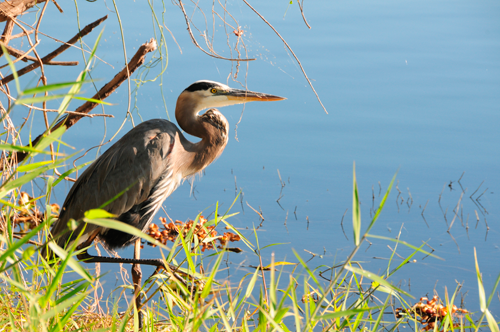
by Alex A. Kecskes
If you own a home near the ocean, river, pond, or lake, you may have had a run in with blue herons. These tall, light blue-grey birds have long black legs, pointed beaks, black bellies, and a black stripe along their white heads.
While they may be beautiful to look at, they can present a nuisance to your property. If you have a Koi pond, for example, you and your Koi may not be too happy to see them. For in addition to amphibians, invertebrates, reptiles, birds, and small mammals, blue herons enjoy feasting on fish.
If blue herons are giving you the blues, here are some humane and effective bird deterrents the pros use:
Bird Spiders
Like most birds, blue herons don’t like spindly things that can strike their legs as they attempt to land. Bird Spiders have long tentacles that whip erratically in the breeze to make birds too nervous to land on rooftops or fence lines. Bird spiders are easy to set up on just about any even surface. The devices come in 2-, 4-, 6- and 8-foot diameter arm lengths to create ever widening zones of deterrence. The best bird spiders come with a glue-on base, so you can easily attach them to most surfaces.
Plastic Bird Netting
An easy-to-handle and install bird deterrent, Plastic Bird Netting creates a physical barrier that will keep blue herons from specific areas of your home. The netting is typically sold in two roll sizes: 14 x 100 feet and 14 x 200 feet. You’ll want a relatively large mesh to block out herons. You’ll also want to invest in high quality, durable, U.V.-protected polypropylene netting, which is strong, light and virtually invisible. Nowadays, bird netting even comes in various colors to blend in with your home.
Solar-Powered Bird Repellers
Equipped with motor-driven “arms” that spin around continuously at 30 RPM, Solar-Powered Bird Repellers make it really rough for herons to land anywhere near them. You can easily position these repellers wherever herons gather most often. The best bird repellers come with adjustable arms that protect up to a 5-foot diameter area. And while they are solar powered, the best devices will also run at night or on overcast days, since they can store the sun's energy for later use.
Scarecrow Bird Deterrents
A silent sentry that springs to life the second a blue heron enters its radius of protection, Scarecrows do a convincing job of keeping birds away from your home. The motion-activated devices greet herons with a harmless water blast, startling sprinkler sound, and realistic looking bird-like moving head. Scarecrows connect easily to your average garden hose and will protect a 1,200 square foot area that extends 35 feet out by 45 feet wide. The best scarecrows will deliver up to 1,000 "firings" on a single 9-volt battery, and you can adjust their sensitivity and range.
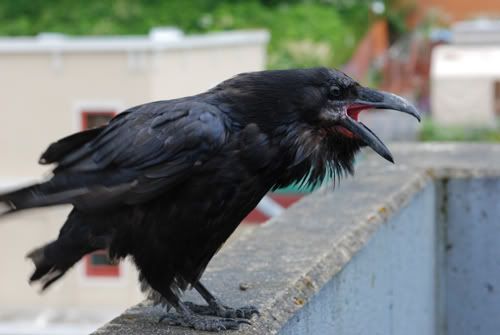 by Alex A. Kecskes If you’ve been invaded by crows, you know the damage they can do to your garden. When they’re looking for worms or nightcrawlers, they can dig dozens of holes in your lawn in just a few minutes. Crows can also damage your prized flowers. And they can be extremely noisy, even in small flocks. New research has shown that crows are among the most intelligent animals on the planet. They can recognize individual human faces and pick them out of a crowd. They will also work together to defend their territories and use “spotters” as lookouts to warn the flock of impending danger. Without effective bird control, they’ll quickly ruin your garden. If your thinking of shooting or poisoning them, crows are protected by federal law. While they can be hunted in certain states during specific times of the year, it’s best to check with your local fish and game department before attempting to shoot crows, or you could be in violation of the law. Of course, unless you live in the wide open country, with no kids or pets around, these draconian measures are too dangerous and impractical. The best way to keep crows out of your garden is to use the bird control devices today's professionals use. Here are three suggestions: Sonic Bird Deterrents If you have a large garden, Sonic Bird Deterrents will deter crows from a wide area. They work on a bird’s psyche by emitting pre-recorded distress and predator calls. Crows will react to these sounds and avoid your garden. If your garden is also being attacked by other birds, you might want to invest in the system that emits distress and predator calls for 22 different species of birds. This system will cover an entire acre and you can program it to turn on or off at night. Bird Spiders Ideal for protecting specific areas of your garden, Bird Spiders have long spindly legs that whip about threateningly in the breeze to discourage crows from landing. Place one or two on a pedestal in your garden, and crows will avoid landing anywhere near them. Bird spiders come in several arm lengths to offer wider and wider areas of protection. Scarecrows Using a motion-activated sensor to detect any bird’s approach, Scarecrows deliver a harmless but quite convincing blast of water to keep crows out of your garden. The devices connect easily to any standard garden hose and will protect a 1,200 square feet area (or a 35-foot by 45-foot wide swath). You can also adjust the sensitivity and blast radius to you specific needs. Scare Balloons These balloons are covered with a large eye, and will bob and weave in the breeze to appear lifelike and intimidate crows. The balloons can be attached just about anywhere, but should be moved around often—remember, crows are extremely intelligent.

by Alex A. Kecskes
While bird populations in North America have dropped considerably in the past 40 years, birds tend to nest or rest on the nation's coasts where nearly half the U.S. human population lives or works. Most birds serve an important role in the ecosystem, but three species of birds in the U.S. are considered pests. Birds categorized as pests include the pigeon, the house sparrow, and the starling. As pests, they can be legally controlled with no justification other than the property owner's displeasure. Of course, there are many other reasons to scare birds away.
Besides being a nuisance and defacing homes, boats, buildings and monuments, pest birds also pose a serious health hazard. Because of their easy and far-reaching mobility, they can vector an alarming variety of serious diseases. Among these are histoplasmosis (a lung disease that can be fatal if untreated), salmonella, ornithosis (a lower or upper respiratory disease resulting in fever, chills and headache), pseudotuberculosis (causing fever and abdominal pain), and several other diseases, including West Nile Virus via parasites (like fleas and mites) that live on their bodies or grow in their droppings.
If you want to scare birds away, it helps to know a little about the birds we regard as pests. The first of our fine-feathered friends is the pigeon. Initially introduced from Europe as pets, pigeon populations have expanded almost exponentially and are now considered by many to be pests. These birds congregate in huge numbers and contaminate public areas with their droppings. They deface both stone and metal monuments, and present a serious risk to aircraft.
Next up is the starling. An imported species not native to North America, starlings nest in roof soffits, electrical boxes, and structural crevices of buildings. Young starlings often gather in huge flocks where their droppings deface and damage structures and monuments, park benches, playgrounds and other areas.
Finally, there's the sparrow. These small birds build fancy nests in gutters, electrical boxes, roof soffits, door housings, and other man-made openings. Sparrows often create expensive problems when they clog rain gutters and downspouts. Their elaborate nests in electrical equipment can cause electrical shorts and fires.
So how to scare birds away?
For pigeons and large birds, one proven and highly effective bird barrier is the use of Bird Spike strip. They look menacing, especially to pest birds, but they won't harm them. The spikes simply discourage birds from landing. Some bird spikes are made of rigid unbreakable polycarbonate. Others employ flexible stainless steel. Another option is the Bird Spider. The spider arms flagellate with the breeze to scare birds away. Spiders are available in a wide range of diameters to deter different bird sizes and cover wider and wider areas. They require little or no maintenance and they won’t harm birds.
One of the most economical ways to scare birds away is through the use of Bird Scare products. These flashy, twirling objects and banners use iridescent reflective foil and shiny tape to create an “Optical Distraction Zone” that discourages pest birds from landing. An unusually effective bird scare product is the inflatable balloon with lifelike reflective predator eyes. These scare-eye diverters are easily attached in areas frequented by birds. Some even feature glow-in-the-dark backsides to repel birds at night. Bird scare products can be easily set up in and around patios, vineyards, pool areas, overhangs, gazebos, boats and other troublesome areas.
A more technical approach to scare birds away involves the use of Electric Shock Bird Repellers. Ideal for pigeons, seagulls and larger birds, these repellers use electrified tracks to impart a mild electric shock when birds try to land. The pest birds are not injured; the mild “jolt” just changes their roosting habits so that they move on. The tracks are easily mounted on signs, ledges, rooftops, and flat or curved surfaces. Some manufacturers offer low profile tracks that are virtually invisible from ground level. Other manufacturers offer electric tracks with a flow-through design to prevent water from damming up on rooftops and other surfaces. Imagine the sound of fingernails on a chalkboard and you'll get an idea of what our next category of bird scare products sounds like--at least to a bird. Known as Audio Bird Deterrents, they produce ultrasonic sounds that annoy birds. Ideal for walled-off or enclosed areas like sheds, parking garages, and overhangs, these audio devices will scare most birds away--birds like pigeons, sparrows, starlings or seagulls. Finally, there's the family of motorized products that work quite effectively to discourage pest birds from landing. These bird repellers utilize rotating arms to scare birds away. Ideal for parapet walls, roofs, signs, billboards, or any flat surface, some are battery powered, others use a plug-in power source. And some are even solar powered.

By Alex A. Kecskes
You’ve got a pest bird problem, and the owner of the commercial building has instructed you to solve the problem--in other words, get rid of the birds! As an astute and experienced property manager, you’ve read about various bird proofing devices and methods. You also know that the owner wants you to use non-lethal means to keep birds away from the property.
Before we go into the various deterrents, you’ll need to walk around the property to determine what types of birds have invaded the premises and where they tend to perch, roost or nest. Note also, the likely places they could choose to move, were you to block access or bird proof these areas. Keep in mind that the most effective way to deter pest birds is to consider all possible perching, roosting and nesting areas. Birds are clever and will quickly adapt to barriers and devices you erect. Sometimes, it helps to take photos of all possible areas bird might use, and to show these areas to a bird control professional.
Having evaluated your premises and determined the “what and where” of your bird problem, it’s time to consider some specific bird control measures. Let’s start with the most popular of pest bird deterrents, the Bird Spike.
To begin with, Stainless Steel Bird Spikes are the most durable. Ideal for deterring large pest birds like pigeons, crows, and gulls, they take away a bird’s ability to land and perch. Bird spikes should be mounted on ledges, I-beams, parapet walls, conduits and signs--wherever pest birds gather before the settle in to nest. Stainless steel spikes come in rows of spiked strips that are 3-, 5- and 8-inches wide. To help you determine the level of protection these spiked strips provide, the 8-inch spikes will give you 8 to 10 inches of deterrence on a 10-inch wide ledge. The best stainless steel bird spikes feature a “no-nest” design with no-gap spacing to keep birds from defeating them.
When installing bird spikes, follow these procedures: Use the staggered pre-drilled holes at the base of the spikes to nail or screw them into place. If you intend to glue them down, use construction-grade adhesives in the glue trough provided in better quality spikes. Better spikes will also feature breakaway notches to bird proof smaller areas. Leave no more than a 1-inch gap on either side of the spike to keep birds from sneaking around them. If you intend to mount bird spikes on a pipe or conduit, use a 1-inch spike to cover 1 to 2 inches and secure each spike with common hose clamps, nylon ties or wire.
Another popular bird proofing device used by commercial building owners is the Bird Spider. These deterrents feature spindly arms that whip about in the breeze to keep pest birds from landing anywhere near them. If you have birds nesting on AC units, water towers, electrical junction boxes and similar flat areas, mount a bird spider on top of these landing zones. They will keep pigeons, seagulls and larger birds from settling in on these areas. Bird spiders come in 2-, 4-, 6- and 8-foot models to provide increasingly wider areas of deterrence. When installing bird spiders, be sure the “tips” of the spider’s arms reach out several inches over the outside surface(s). Allow the arms to move freely with the tips no more than 2 or 3 inches above the mounting surface. When using glue to mount the spider, use the PVC adapter (provided by better bird spiders). If you’re installing more than one spider, position them 6 to 8 inches from arm-tip to arm-tip.
One last advisory note: Before installing bird barriers, dry up any water-damp areas and remove any loose rust, peeling paint, bird droppings, feathers and nesting materials. Birds will be drawn to the familiar scent of their species and regard the area a hospitable. Be sure to use commercial disinfecting cleaning agents to prevent installation crews from being exposed to the many airborne diseases carried by birds and their droppings. Use eye and respiratory protection if the area is heavily contaminated with droppings.
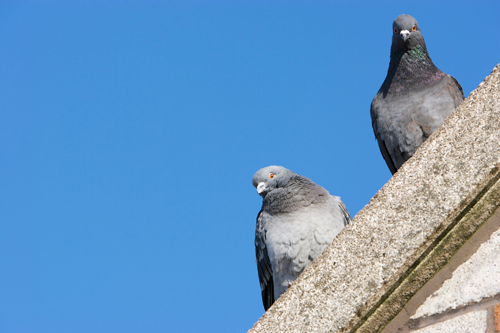 by Fran Prisco Pigeons can be found in just about every city and suburb in North America. They were first introduced to the United States as domesticated birds that soon escaped and formed wild pigeon populations. Ancestors of the Rock Dove, city pigeons like to roost and nest high atop buildings where there is safety from predators. They cause thousands of dollars every year to buildings and homes across the country. The droppings of pigeons are acidic and will accelerate the deterioration of building materials. Pigeon droppings also can carry any of 60 plus transmitted diseases. The best way to keep pest pigeons off of buildings is to install some sort of bird barrier . Sanitation It is important that all debris and droppings left behind by the pigeons is removed before installing any type of bird barrier . Inhaling the dust from pigeon droppings has been known to cause histoplasmosis, cryptococcus and psittaicosis. If you use some simple protective methods while cleaning up pigeon droppings, you can eliminate the danger of catching any of the above-mentioned diseases. Be sure to wear some sort of protective gear such as a facemask and rubber gloves. Wet pigeon droppings with water so that they do not emit any dry dust, use a scraper to scrape the wet droppings into a dustpan and dispose of them in trash bags. Types of Bird Barriers Electric Bird Barriers are electrified track that give pigeons a small “jolt” when they touch the track. They are easily installed on parapet walls, roof edges and peaks, ledges and even channel letters. Install the track with an outdoor adhesive and connect to a solar or direct charger. When the pigeons are “Zapped” by the electrical current running through the track, they will change their landing and roosting habits and find another more comfortable area. Electric bird repellents are low profile, usually no more than ¼” high, which does not take away from the buildings aesthetics. These bird control electric tracks are one of the most specified systems by architects, government offices and contractors.
Bird Netting is used on and in commercial buildings with severe bird problems. Bird net is an exclusionary bird deterrent; it excludes birds from areas that they are unwanted. Bird netting is ideal to use in large warehouses, airplane hangars, “Big Box” stores and food processing plants. It can also be used on building facades to protect signs, channel letters and architectural features. It is best to hire a professional to install bird netting , if not done properly, the netting may sag and allow birds to get underneath it. Bird Spikes are an ideal way to keep larger birds such as pigeons and gulls from landing on commercial buildings. They are easily installed using adhesive, screws or tie downs. Use bird spikes to keep birds from landing on ledges, roof edges and peaks, parapet walls, windowsills and other flat surfaces. Be sure to cover the entire surface with bird spikes so the birds cannot land around them. Often times, if birds can land around the spikes, they will use them as a nesting area. Made from stainless steel or polycarbonate plastic, bird spikes are rugged and long lasting bird barriers . Once installed there is little maintenance; periodic cleaning of debris buildup from nearby trees or shrubs is all it takes.
|









 by Fran Prisco
by Fran Prisco RSS Feed
RSS Feed